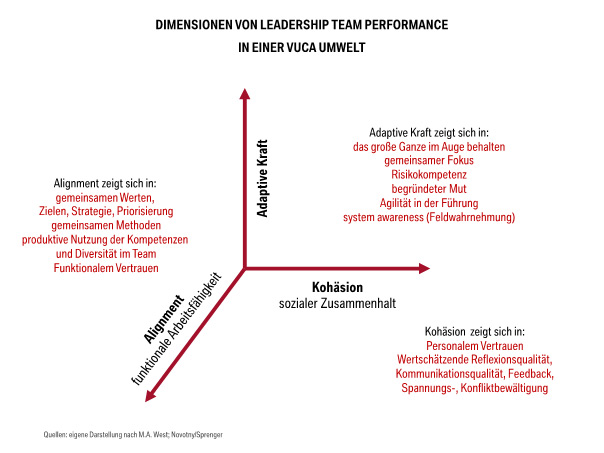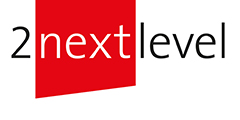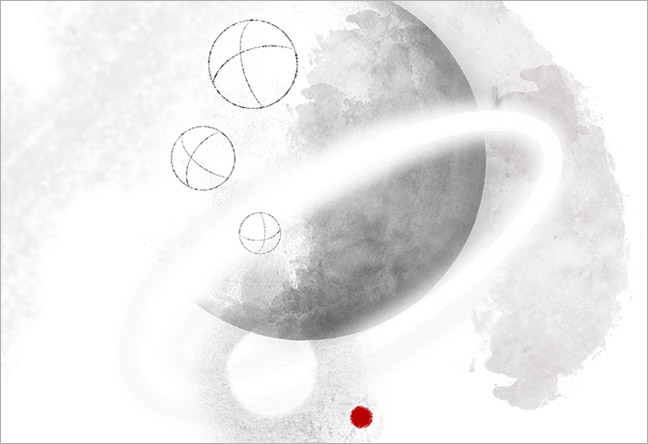The advantages of teams – especially their diversity of skills – outweigh the disadvantages in a turbulent environment, such as more difficult communication and coordination. However, these advantages only come into play if the leadership team succeeds in balancing functional work ability and social cohesion. Over- or under-emphasis on one area leads to suboptimal performance.
In the VUCA and beyond world, teams need another capability: the adaptive power of learning. How does this power develop?
The team is the smallest cell of collective intelligence in an organisation. Creating communities of meaning and shaping a “corporate culture” is a must for good leadership (Prof. Peter Kruse). Studies show that the formation and pursuit of common goals etc. forms a basis for the emergence of a common identity and thus strengthens team cohesion (e.g. Atwater & Spangler 2004).
Team cohesion also takes on a new quality in a turbulent environment. Senge and Scharmer describe three main obstacles to paradigm shifts and transformational change: narrowness of one’s own judgement (voice of judgement), hurtful cynicism (voice of cynicism), anxious defensiveness (voice of fear). A productive relationship dynamic has three components:
- Respect and appreciation for the contribution of others
- the psychological security of the individual to be able to freely express his or her perceptions, opinions, ideas, suggestions, and
- openly showing “vulnerability”, e.g. admitting mistakes, expressing ignorance, asking supposedly “stupid” questions.
The goal is not to create harmony, chumminess or the lowest common denominator in the team, but passionate, hard-hitting discussions from which clear decisions emerge without personal injury. Ultimately, the best indicator of team capacity is results.
A team develops a sustainable adaptive strength when it is aligned in its content and methodical handling of tasks, acts clearly and has developed an appreciative culture of conflict in its social cohesion. Adaptive power is thus a resultant of alignment and group cohesion. It is an energy that works beyond the interests and needs of the individual team member. A common purpose helps to keep the direction.

High performance leadership teams can be described as teams whose members
- appear and act cohesively
- challenge each other (“friendly confrontation”), stick together even under high pressure and do not try to assert their individual interests
- act independently – but within the framework of co-responsibility for the whole – not in competition with each other
- Strike a balance between openness, trust and feedback.
- use metacommunication, self-reflection and feedback as a matter of course in terms of content and process.
What stands in the way of alignment:
- Voice of judgement and downloading
- Solidarity behind political statements. The alphas in the group have the authority of interpretation.
- The thoughts of other team members are ignored or assimilated (ego-centred thinking). The others are allowed to complement what the opinion leader thinks.
- Right-winging and self-promotion end up in unproductive arguments.
What leads to alignment:
- Agreement on common vision, goals, values, strategy, priorities and approaches/methods.
- Functional trust: using all the diversity of expertise and experience in the group; not stopping at a false consensus.
What stands in the way of cohesion:
- Confusion with cronyism
- “Non-aggression pact”: Closeness that no longer allows for critical reflection because people don’t hurt each other among friends or “if you don’t do anything to me – I won’t do anything to you”.
- Apparent emotional consensus: feeling of agreement is confused with practicability and solution quality
Which leads to cohesion:
- Everyone contributes
- Clarity
- Distinguish between role and function
- Showing vulnerability, i.e. courage to admit mistakes (and learn from them)
- Courage to call others on mistakes
- Respect-esteem: not “devaluing” others to feel better about oneself.
How can we situate ambidexterity: Ambidexterity in leadership requires risk-taking skills and reasoned courage – adaptive strength. The ability to learn, to decide with each other where there is a need for proven approaches focused on efficiency and excellence and where there is a need for approaches more focused on speed, agility and innovation. This applies to the team’s own area and to the network in which it operates. It is to be expected that the different logic and dynamics of the ‘two hands’ will create additional complexity. Successful leadership teams move in parallel structures and atmospheres without losing their ability to act.
Translated with www.DeepL.com/Translator (free version)



